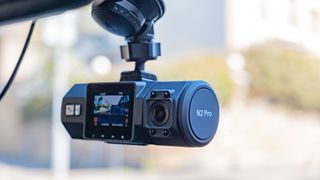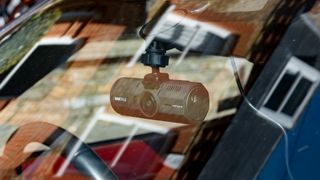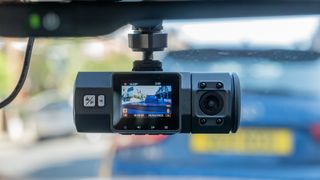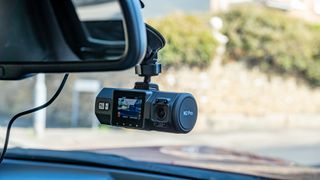Two-minute review
You’re not alone in thinking the Vantrue N2 Pro is a curious-looking dash cam. The angular body with buttons, lenses and design details seemingly scattered across every surface, is unlikely to win many awards on aesthetics alone. But not many of the world’s best dash cams are design pieces, so we’re willing to mostly skip over the design of the N2 Pro and instead focus on its features, functions and performance.
Although not attractive, the Vantrue is reasonably compact considering it houses a pair of cameras, plus a TFT display and six buttons used to navigate the operating system. Aimed primarily at taxi and rideshare drivers, this dash cam records forwards out of the windscreen, but also rearwards into the interior – keeping an eye on the traffic, but also on fare-paying passengers, too.
The front-facing camera records at up to 2.5K, which is a resolution of 2560x1440p, at 30 frames per second or 1920x1080p at 60fps, through a 170-degree lens. We say ‘up to’, because maximum resolution and frame rate are only possible when the rear camera is disabled. Switch the camera to record in both directions at once, and both are capped at 1080p and 30fps; the rear lens has a field-of-view of 140 degrees.
The interior camera is aided with infrared night vision to help produce a clear, greyscale, view of the driver and their passengers at night. Again, this is very much a dash cam for taxi drivers rather than car owners generally. The secondary camera can be rotated 45 degrees up or down to ensure a good view.
A suction mount is included in the box, which is good news for those who don’t want an adhesive pad forever stuck to their windscreen. This slots into a mount on the top of the dash cam, which then locks into place. It isn’t the most elegant mounting system we’ve seen, but it does the job.
The mount has a USB port of its own, so the dash cam can be powered either via this connection, or directly from its own USB socket. If you’re permanently installing the camera in your car, plugging into the windscreen mount makes most sense, as then the cable is closer to the roof lining, into which it can be hidden and routed to the car’s USB port or 12V socket.
That said, a rotating lock used to secure the suction mount takes up a fair bit of space, and because it rotates upwards to the 12 o’clock position, it is likely to touch the roof lining at the top of your windscreen, or the plastic housing of your car’s own forward-facing cameras and sensors. For us, this meant placing the dash cam lower down the windscreen than we’d like, partially blocking our view of the road ahead. Admittedly, our car has a small, shallow windscreen, and owners of larger vehicles shouldn’t have any problems.
A short USB cable, plus a longer cable attached to a 12V lighter socket adapter with integrated USB port, are both included in the box. A microSD card is not included, so you’ll have to provide your own.
Bucking a trend followed by most other dash cams, the Vantrue N2 Pro has no wireless connectivity at all. Although the lack of GPS is disappointing, as this helps to add accurate speed and location data to video recordings, we wonder if some buyers will actually welcome a dash cam that works without first installing a smartphone app.
There’s no Bluetooth or Wi-Fi, so the camera is entirely self-contained – and crucially, there’s no account creation process and no submission of personal data to Vantrue. You just insert a microSD card, plug the camera in, adjust a few settings via the display, and away you go.
While that will appeal to some buyers, the downside is that footage cannot easily be transferred to a smartphone. Instead, you need to remove the memory card and pop that into your computer or tablet. We’re not convinced this is a total deal-breaker, although removing a pointless cover every time you want to access the SD card is a frustrating design quirk.
Also strange is the button layout, where those for scrolling through the menu system are on the underneath, but the ok/select button is on the front – and for good measure it’s a different shape and color, too. No, we don’t know why either.
Navigating the system is simple enough (pro tip: you’ll want to turn the annoyingly loud button beeps off right away), but don’t be fooled by the GPS setup page. This only works if you buy Vantrue’s GPS-equipped windscreen mount separately.
We were pleasantly surprised by the video quality of the Vantrue. Setting both cameras to Full HD produced footage that is sharp, clear and smooth, with crucial details like registration plates and street signs easy to read. The interior camera sometimes struggles a little in bright sunlight, with parts of its view washing out, but this is only a small criticism of what was otherwise an impressive performance.
Audio quality is also good, and while most dash cam buyers will likely switch this off in the interests of passenger privacy, taxi drivers could benefit from decent sound if they ever need to provide evidence against misbehaving passengers.
A hardwiring kit is available separately for giving the Vantrue a constant power supply from the car’s battery. Doing this frees up the 12V socket, but also enables the dash cam’s parking mode, which records footage when movement is detected.
There isn’t much more to say about the N2 Pro and, honestly, we think that’s a good thing. Good video quality is far and away the most important dash cam feature, and we’ve often felt some models overwhelm the buyer with too many additional features.
Some consumers will demand Wi-Fi for quickly transferring footage to a smartphone, or Bluetooth for configuring the dash cam via an app. But we suspect many others will like how simple the Vantrue is and, aside from it lacking GPS, we think that simplicity is a good thing.





